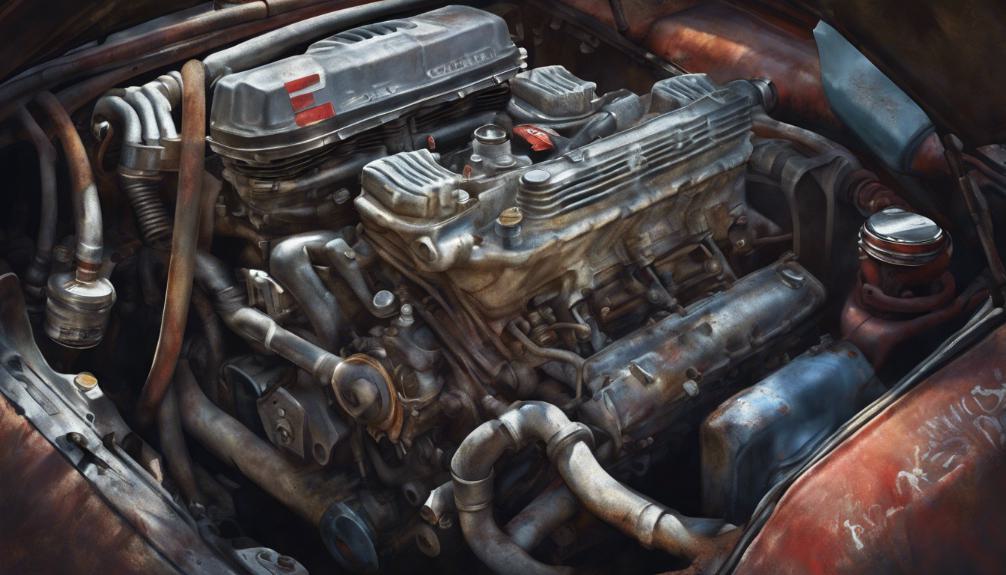To troubleshoot a P2635 code about fuel pump A flow performance, focus on calibration discrepancies and pressure impacts. Understand diagnostic steps for optimizing fuel delivery. This aids in efficient issue resolution and maintaining peak engine performance. Explore the causes of the code and take steps to address them promptly. Identifying root causes, considering upgrades, and monitoring indicators are vital. Learn how to prevent these issues by staying proactive and seeking professional advice. By understanding these critical aspects, you can guarantee your vehicle's health and performance are optimized. More insights await on resolving P2635 code for fuel pump A issues.
Key Takeaways
- Diagnose pressure variance caused by auxiliary pump.
- Optimize tuning and calibration for fuel pump A.
- Monitor fuel pressure, A/F ratio, and boost levels.
- Consider upgrades for fuel pump performance.
- Utilize resources for tuning guidance like DSX blog.
Common Causes of P2635 Code

If you're troubleshooting a P2635 code, one common cause worth exploring is differences in OEM pump pressure. Fuel pump calibration and pressure regulation play vital roles in guaranteeing the correct flow of fuel.
Discrepancies in the pump pressure, especially when compared to the original manufacturer's specifications, can lead to the triggering of the P2635 diagnostic trouble code. The calibration of the fuel pump is essential for maintaining ideal pressure levels within the system.
When the pressure regulation deviates from the expected range, it can impact the performance of Fuel Pump A and result in flow issues that trigger the DTC. Hence, it's important to carefully check and adjust the pump pressure to align with the OEM standards.
Diagnostic Steps for Fuel Pump A
To proceed with diagnosing Fuel Pump A, start by examining the pressure difference triggered by the auxiliary pump. Fuel pump diagnostics and troubleshooting are essential steps in resolving performance issues.
When facing a P2635 DTC, it's important to turn it off and focus on proper tuning and optimization. Monitoring fuel pressure at the rail, A/F ratio, and boost can aid in early failure detection.
For well-tuned, forged, supercharged vehicles, proper sensor monitoring is paramount. Performance tuning is a key aspect of addressing fuel pump A flow performance issues.
By following diagnostic steps and troubleshooting methods, you can optimize the fuel pump's performance efficiently. Conduct a thorough examination of the pressure difference triggered by the auxiliary pump to pinpoint any underlying issues affecting Fuel Pump A.
Stay vigilant in monitoring key indicators to maintain peak performance and prevent potential malfunctions.
Resolving Fuel Pump Performance Issues

When addressing fuel pump performance issues, prioritize identifying the root cause to implement effective solutions efficiently. One way to enhance fuel pump performance is by considering fuel pump upgrades.
Upgrading the fuel pump can provide increased flow rates and better pressure regulation, addressing issues related to P2635 code triggers. Moreover, tuning adjustments play a crucial role in optimizing fuel pump performance.
Proper tuning can help guarantee that the fuel system is operating at its peak, preventing flow performance issues. Utilize resources like the DSX tuning blog for guidance on fine-tuning adjustments to improve fuel pump efficiency. Monitoring key indicators such as fuel pressure at the rail, air/fuel ratio, and boost levels can also aid in early detection of potential fuel pump failures.
For well-tuned, forged, supercharged vehicles, proper tuning and potential fuel pump upgrades are essential to prevent and resolve fuel pump flow issues efficiently.
Importance of Addressing P2635 Promptly
Address the P2635 code promptly to prevent potential fuel delivery issues and engine damage. Ignoring this code can lead to disruptions in fuel pump performance, affecting engine efficiency.
Fuel pump maintenance is vital for proper engine function, and resolving the P2635 issue promptly can prevent costly repairs down the line. By addressing this code promptly, you guarantee that the fuel pump operates at its best capacity, which directly impacts the overall performance of your vehicle.
Engine efficiency relies heavily on the proper functioning of the fuel pump, making it essential to monitor and address any related issues promptly. Neglecting the P2635 code can't only lead to fuel delivery problems but also result in severe engine damage over time.
Therefore, taking swift action to rectify this code is key to maintaining your vehicle's health and performance.
Preventative Measures for Future Occurrences

Regularly inspecting and maintaining active grille shutters can help prevent binding issues and guarantee peak vehicle performance. By ensuring these shutters are clean and functioning correctly, you can avoid potential issues that may lead to fuel pump performance problems triggering the P2635 code.
Moreover, staying proactive in monitoring the fuel pump for any signs of intermittent performance can help you address issues promptly before they escalate. Consider exploring aftermarket solutions for upgrading the fuel pump to improve both its performance and reliability. These upgrades can enhance the overall efficiency of the fuel system, reducing the likelihood of encountering the P2635 code in the future.
If you face persistent challenges, consulting with a professional technician for troubleshooting techniques and performance enhancements can provide you with advanced diagnostics and maintenance tips to prevent the recurrence of the P2635 code. Stay ahead of potential issues by investing in proper maintenance and exploring upgrading options for your vehicle's fuel system.
As an Amazon Associate we earn from qualifying purchases.










